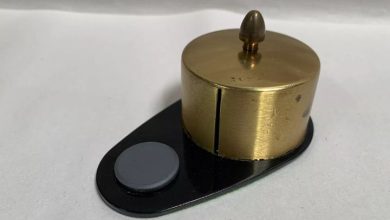
ADVERTISEMENT
The Traditional Hand Plow: A Tool of Agricultural Heritage
The object in the image is a traditional hand plow, a simple yet highly effective tool used for soil cultivation and preparation. These plows, often crafted from wood and metal, were a staple in agriculture for centuries before the advent of mechanized farming. Here’s a detailed exploration of this fascinating artifact:
ADVERTISEMENT
1. What is a Hand Plow?
A hand plow, also referred to as a manual plow or primitive hoe, is a tool designed for loosening and turning soil. It typically features:
- Wooden Handle or Frame: Shaped to provide a comfortable grip and leverage for the user.
- Metal Blade: The sharp, durable blade is used to cut through soil and create furrows for planting seeds or removing weeds.
This tool was an essential component of traditional farming systems, particularly in regions where manual labor was the primary means of cultivating land.
2. Key Features of the Traditional Hand Plow
- Ergonomic Design: The wooden handle is often hand-carved to fit comfortably in the user’s grip, ensuring effective use over long periods.
- Durable Materials: The blade is made from iron or steel, which can withstand the rigors of cutting through compacted soil and roots.
- Lightweight Construction: The combination of wood and metal makes it portable and easy to maneuver.
3. Historical Significance
Hand plows have been used for thousands of years, predating mechanized agriculture. Their history can be traced to early agricultural civilizations, including:
- Ancient Egypt: Farmers used wooden plows pulled by oxen to till the fertile lands along the Nile.
- Asia and Africa: Similar tools were developed independently, often tailored to local soil and crop requirements.
Even into the 20th century, hand plows were widely used by small-scale farmers around the world, especially in rural or less industrialized areas.
4. How It Was Used
- Soil Preparation: Farmers would use the plow to break up hard soil, improving its aeration and making it suitable for planting.
- Furrowing: The blade would create shallow trenches (furrows) to plant seeds in rows.
- Weeding: The plow could be used to remove weeds and other unwanted plants between crop rows.
- Flexibility: Small and versatile, it could be adapted to a variety of terrains, including small plots and uneven ground.
The tool required physical strength and endurance, often necessitating teamwork during long hours in the fields.
ADVERTISEMENT
5. Cultural and Economic Importance
- Sustainability: The hand plow was an eco-friendly tool, relying solely on human labor and not requiring fuel or electricity.
- Community Symbol: It was often passed down through generations, symbolizing the connection between families and their land.
- Economic Accessibility: Compared to large, mechanized equipment, hand plows were affordable and easy to maintain, making them an ideal choice for subsistence farmers.
6. Modern Context and Legacy
While mechanized farming tools have largely replaced hand plows, they remain in use in certain regions and contexts:
- Small-Scale Farming: Some farmers still prefer hand plows for small gardens or organic farming.
- Cultural Preservation: In many communities, traditional tools like the hand plow are celebrated as part of their heritage.
- Eco-Friendly Agriculture: With a growing focus on sustainable farming practices, hand tools are being revisited for their low environmental impact.
7. Conclusion
The traditional hand plow, as depicted in the image, stands as a testament to human ingenuity and resilience. Its simplicity, effectiveness, and cultural significance make it an enduring symbol of traditional farming practices. For those interested in history or agriculture, it serves as a reminder of the deep connection between humans and the land they cultivate.
If you’d like further insights into the history of traditional tools or tips on how to preserve and display such artifacts, feel free to ask!
ADVERTISEMENT




